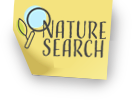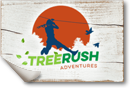Invasives: What are they and how you can stop them from spreading
article by Michelle Foss, Director of Resource Stewardship
National Invasive Species Awareness Week is an international outreach event put on by the North American Invasive Species Management Association, that occurs annually at the end of February.
What is an invasive species?
The term “invasive species” has become more prevalent over the past few years as pests such as emerald ash borer (Agrilus planipennis) and spotted lanternfly (Lycorma delicatula) spread, causing destruction and devastation across the country. If you have read some of our previous posts regarding invasives, you know that invasive plant control is a large part of our habitat restoration efforts. But as a refresher, invasive species are living things (typically non-native) that invade a habitat or ecosystem and cause harm to said habitat or system. Not all non-natives are bad, and not all invasives are non-native. Native organisms can become invasive when there is an imbalance in the system, such as the eastern red cedar (Juniperus virginiana) taking over grasslands here in the Midwest.
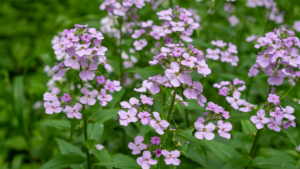
Dames Rocket (Hesperis matronalis)
How invasives spread and what can be done to stop them
So, how does a system become invaded? There are a variety of ways, many of which depend on the actions or inactions of humans. A common way invasives occur is by humans transporting them between locations. For example, a gardening plant like dame’s rocket (Hesperis matronalis) may be intentionally transported from Europe, or zebra mussel (Dreissena polymorpha) larva might microscopically hitch a ride from one water source to another in boat ballast water. Released bait can also become invaders, such as rudd (Scardinius erythrophthalmus), which are invasive species that can outcompete native fish in Nebraska. Escaped garden plants can become a concern in native areas, especially in urban locations. At the Forest, we encounter shrubs, flowers, grasses and creeping vines that have invaded from nearby yards (and surprisingly, sometimes from yards that are not-so-nearby).
Once an invasive is introduced to a system, the spread rate and ecological impact determines how much of a threat it becomes. For example, emerald ash borer can travel quickly through dead wood, reproduces at a high rate, and decimates ash trees they come across, making them a high threat. Some invasives, like garlic mustard (Alliaria petiolata) in our oak woodlands, can be neutralized by controlling certain factors. For example, once we started opening the canopy and restoring the native habitat, native plants outcompeted the garlic mustard, thereby reducing the threat of the invader.
I can’t get rid of them! Now what?
If an invasive becomes entrenched, complete removal is usually not possible due to the high cost. In that case, we focus on controlling the invasive in an effort to give the native system a chance to thrive. While controlling invasive species is important, it’s only one aspect of our conservation efforts. We have to prioritize our time, energy and resources, so we can’t eliminate all invasives. In addition to the initial removal, there are often residual leftovers – eggs or dormant seeds for example. These can require follow-up for many years, and if not addressed, can result in reinvasion. In very extreme examples, such as tree of heaven (Ailanthus altissima), root suckers can sprout up far away from the original parent tree, causing problems for neighbors as well!
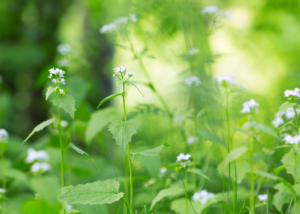
Galic Mustard (Alliaria petiolate)
The power of partnerships. Working together to promote native habitats.
There is hope, however! Promoting native habitats also builds resiliency, which provides the system a better chance at defending against invaders. With increasing focus on planting natives for pollinators and yard habitats, the availability of native plants in the Omaha area is increasing. As a result, the popularity of some invasive plants is decreasing.
With conservation at the forefront of our mission, we strive to educate the public on how you can play a role in supporting native habitats. Being a small nonprofit, we partner with other local organizations that have a similar mission in order to increase exposure and impact.
Fontenelle Forest is proud to partner with local native plant resources like the Nebraska Statewide Arboretum and Mulhall’s, among others. Each summer Fontenelle Forest hosts an annual native plant sale with the Nebraska Statewide Arboretum. Additionally, Fontenelle Forest is Mulhall’s 2023 Round-up Partner. So, just by purchasing plants at Mulhall’s and “rounding up,” you’ll be making a donation in support of the Forest’s mission to maintain our native habitats, while also creating your own native habitats!
Interested in learning more or volunteering?
Are you interested in learning more about the varied ecosystems within Fontenelle Forest and our mission of conserving them for generations to come? Are you interested in volunteering with our land management team to keep the Forest healthy and beautiful?
Sign up for our Land Steward volunteer e-mail list here. We hold monthly Saturday workdays. The information is sent out about ten days in advance.
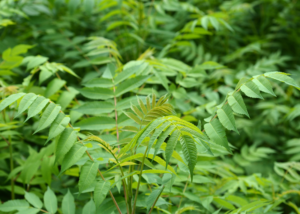
Tree of Heaven (Ailanthus altissima)
If you don’t have a garden or landscaping, and can’t get out to a workday, you can still help!
You can support the Forest’s mission by simply sharing this information, educating your friends and family about invasive plants, and encouraging them to research what native plants are available in their area. It will result in more habitat-producing native landscapes. Not only will these landscapes be more resilient, they will also save time on mowing, watering and general upkeep!
For more information about National Invasive Species week, check out www.nisaw.org/.

